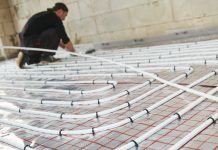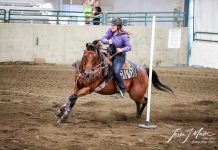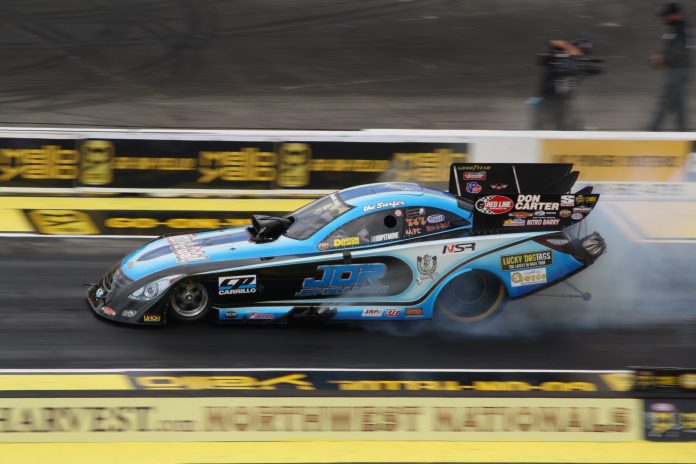
In the fastest ranks of the National Hot Rod Association (NHRA)—known as Top Fuel—a race car with a nitromethane-powered engine produces upwards of 10,000 horsepower, rocketing down a 1,000-foot drag strip in less than 4 seconds at speeds greater than 330 miles per hour.
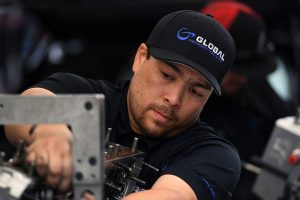
Whether they’re slender, rear-engine dragsters or shorter, front engine funny cars, these cars are among the fastest-accelerating land vehicles on earth, going from 0 to 60 mph in under 1 second.
Getting peak performance from these vehicles requires a combination of mad science and precise mechanics, and each team is comprised of professional crews with specific tasks for each part of their car.
Between runs down the dragstrip during qualifying and races, these crews disassemble and reassemble a car’s engine in as little as 40 minutes in often loud, hot and cramped pit areas.
Mount Vernon’s Troy Sato is one of these crew members. “One of my favorite things about working on these cars is figuring out how to do something really complicated, as fast and efficiently as you can,” says Sato, a 2003 Mount Vernon High School graduate.
Finding a Path
Sato grew up watching a different kind of racing, sprint cars, at Skagit Speedway. His favorite driver was Jerry Bundy, a well-liked racer known as “The Wheelie King.” After high school, Sato moved to Wyoming to attend the WyoTech automotive training school, studying chassis fabrication and high performance engines.
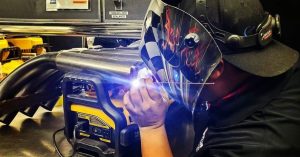
It was also during this time that he encountered professional drag racing up-close, attending a day of qualifying at Bandimere Speedway’s NHRA Mile-High Nationals outside Denver. Sato was hooked. Although he also tried his hand at working on a World of Outlaws sprint car, Sato’s automotive direction shifted permanently after a few phone calls to NHRA teams.
Sato worked for several different Top Fuel operations, including Bob Vandergriff Jr.’s UPS dragster in 2006. But wrenching on nitro engines wasn’t Sato’s only passion in life. He also loved hockey, specifically roller hockey.
In 2010, realizing that his window for being a professional NHRA crew member was wider than his window for playing hockey, Sato took a fabricator job back in Skagit County, working for a company building aluminum fishing equipment for the Alaskan fishing industry.
At the same time, he continued training and competing in roller hockey. Sato became a goalie for the United States national team, ultimately playing the sport on four different continents. He competed at the 2010 CSP Copa America tournament in Spain, and that fall helped the team win its third B-level World Championship at the Roller Hockey World Cup in Austria.
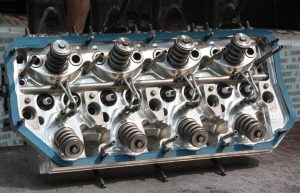
The title sent him to the 16-team, A-level World Cup in Argentina in 2011, and Sato again played for the team during the 2013 World Cup, held in the African nation of Angola.
In 2014, Sato went to Germany to try out for ERG Iserlohn, a European roller hockey team, while also dipping his toes back into the NHRA waters as a crew member for Jeff Diehl’s Funny Car.
The next year Sato reached new heights in his hockey career, goaltending the Burlington-based Skagit Spartans to a national championship in the world division that July. The next month, he accepted a goalie position with ERG Iserlohn and moved to Germany.
Sato helped the team win the Rollhockey Bundesliga 2015-16 championship – the biggest roller hockey championship in Germany – before returning home to Skagit County.
Seeking a Win

In 2017, Sato turned his attention back to fabrication and drag racing, starting his own business, Pacific Northwest Fabrication, and hitting the NHRA trail with Kalitta Motorsports as a member of Shawn Langdon’s Top Fuel dragster team.
Since then, Sato has continued his own business while crewing for Tim Wilkerson’s and Paul Lee’s Funny Car operations. He’s mostly focused on cylinder heads, but has also taken turns working with nitro engine clutches and bottom ends—the bottom side of the engine block, often considered the messiest and dirtiest crew position.
Sato’s latest job is with Clay Millican’s Parts Plus dragster, a competitive team he hopes will help him finally capture his first NHRA victory, after previously crewing cars to final rounds and number one qualifying positions. “I want to win a race,” he says. “And I want to learn as much as I can along the way.”
Though the work of an NHRA crew member entails high pressure, long hours and even longer travel that requires getting along with an entire team of diverse people, Sato says the laughs and learning over the years has made it all worthwhile.
Decades after watching race cars circle Skagit Speedway, Troy Sato wants to keep going just a little bit faster.



